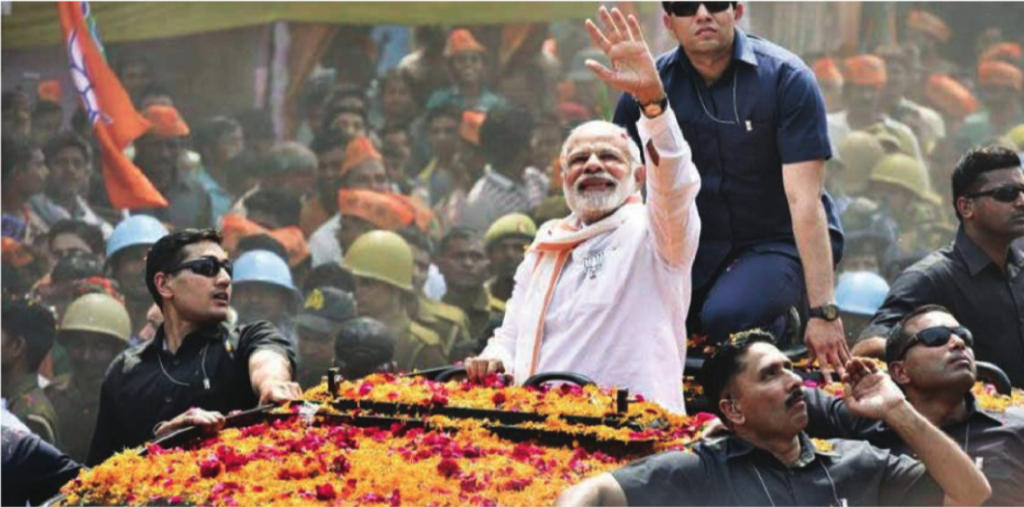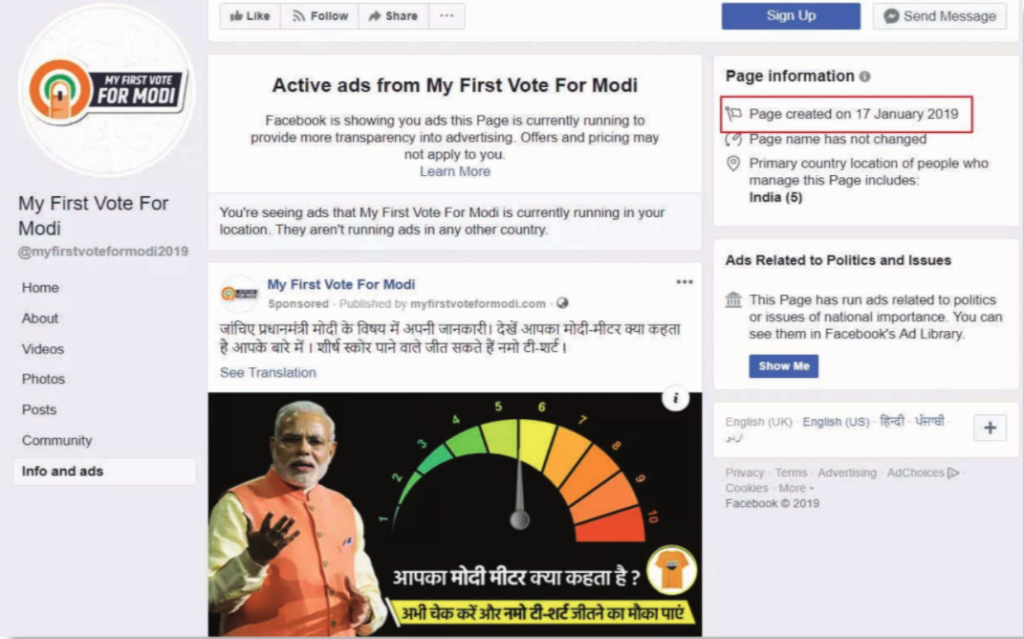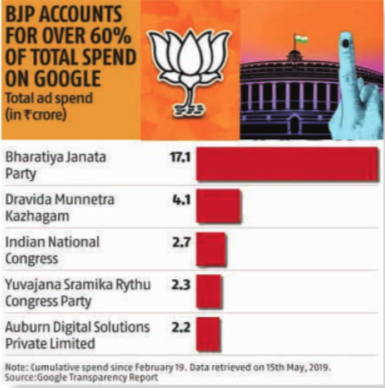The BJP engaged in information warfare to capture the voter’s mind-space months before the election, and sustained it through the heat of the seven-phase campaign
By Geeta Singh
“Kam Se Kam Kharch me hum Chunaav lad sakte hai kya? Dekhiye main Ahmedabaadi hoon pakka, hum Ahmedabaadiyo ki ek pehchaan hai, woh single fare main double journey waale hote hai. Bina kharcha chunaav lada ja sakta hai, aap lad payenge kya? Main tarika batata hoon. Dekhiye aapke polling booth me maan lijiye 1000 vote hain, matlab 250 parivaar hain. 250 parivaar me maan lijiye aapke paas booth me 25 karyakarta hain to ek karyakarta ke jimme 10 parivaar aayenge aur us karyakarta ko bata do tumhara TV, akhbaar, Chai- nashta ka kharcha band. Shuru main vo chilayega. Liken Kya karna hai ki aapko jo 10 parivaar diye hai to subah ke samaye ek parivaar ke ghar pahunchiye, haal chaal lijiye, chai pee jiye, phir dusare ghar me akhbaar padiye agar nashta ka time ho gaya hai to bhabhiji ko kahiye – hamne suna hai ki bhabhiji aap bahut badiya nashta banati hain. Toh bhabhiji nasta kara dengi. Chunaav Kharch aise bachega ya nahin.”
(Can we fight an election with a minimum expenditure? I am a Ahmedabadi. Ahmedabadis are identified as those who want to undertake an up-and-down journey with a single journey fare. Elections can be fought without spending money.
Can you do it? I will show you a way. See, if in your polling booth there are 1000 voters, that is 250 families. If there are 25 booth workers, it means that every worker is responsible for 10 families.
Tell the booth workers that his TV, newspaper, breakfast allowance is discontinued. He will scream at first. But what do you have to do who have been given the responsibility of 10 families? Reach the house of a family in the morning, enquire about their well-being.
Then go to the next house. Read the paper there. If, it is breakfast time tell the lady of the house that you have heard about the tasty breakfast she serves. Then she will serve you breakfast. The election expenditure is minimized in this way.)
It was one of the interesting pieces of advice from Prime Minister Narendra Modi to his booth level workers before filing his nomination from Varanasi. He told the booth workers to spread the campaign without spending any money.
Not only that, it will be a new way to meet the families of every home of Varanasi. These indigenous methods of campaigning gave a different level of enthusiasm among the young cadre.
But he also reminded party workers that the job of PM is not fun nor is it a picnic. It is a job that requires tenacity and perseverance. In his words, “Yeh pradhan mantri ka pad mauj-masti ke liye nahin hoota hai, is pad par reh kar khud ko tapaana padta hai”.

Can we fight an election with a minimum expenditure? I am a Ahmedabadi. Ahmedabadi’s are identified as those who want to undertake an up-and-down journey with a single journey fare. Elections can be fought without spending money. Can you do it? I will show you a way
And booth level workers did their job perfectly by sending this message to voters successfully. These messages spread through word of mouth not only in Varanasi but almost in every constituency of Uttar Pradesh and impacted very well against opposition leaders who were aspiring to be prime minister.
The call for low expenditure was good motivation for BJP workers, but 2019 elections saw four times more spending than 2014 elections. Around 600 million people have cast their votes in which 10.8 million were first-timers.
The propaganda of BJP was bigger than it has ever been before. It was everywhere – on the social media, on television, in newspapers, over the radio and the billboards. As per sources, Congress spent around Rs 2000 cr, and BJP’s spending was 10 times that of the Congress, say around more than a whopping Rs 20, 000 crores.
Modi’s campaign team adopted the theme of nationalism and Hindutva in this election. Party’s promotion and publicity was handled by Soho Square, Ogilvy & Mather and Madison World. These companies had handled Modi’s and BJP’s campaign in 2014 as well. But this time promotion was very well executed, online and offline.
Grassroot Level Campaign
Narendra Modi alone had larger-than-life cut-outs, 51 days of campaigning, 142 rallies plus around four roadshows and number of interviews to media apart from a long, apolitical, candid interview with film star Akshay Kumar. Overall, BJP has done more than 1500 rallies in which Amit Shah has done 161.
Out of 142 solo rallies of Modi, one-third of them were in Uttar Pradesh and West Bengal. The target was clearly to promote Modi’s work in these states. He wanted to reach maximum people.
So, in addition to rallies he addressed meetings through digital mediums like video conferencing and through WhatsApp. This time there was no wave visible like in the previous general election but somehow a tangible campaign was sustained, thanks to RSS. And this invisible wave has washed away the Congress, again.
Since last general elections, BJP has increased membership five-fold. With more than 110 million members, it has the biggest number of members for any political party in the world.
And there are more than 1.5 crore unsalaried voluntary young and middle-aged karyakartas who actively participated in the elections to influence voters, thanks to Jio for the free data.
These pro bono cadres have been trained through lectures, speeches and textual contents to spread the political campaign of Modi. From the economy to nationalism these foot-soldiers put forward policies and ideology of Modi to the electors.
They countered and manipulated the populist idea of NYAY pitched by Congress president Rahul Gandhi. The BJP cadres trained under Pandit Deen Dayal Upadhyaya Prashikshan Mahabhiyan programme, which publishes books, was instrumental.
Two year before the election, Modi and Shah started working on the ground. Modi addressed more than 116 programmes for booth workers. The party had set up committees for 8.6 lakh of 10.5 lakh booths in the country.
Shah had also demanded that his party workers organise events at regular intervals to keep the people’s interest alive. Details of each event were digitally recorded. “We have organised at least four programmes in each of the 3,800 assembly seats in the country,” Shah said.
Adding to that, the party organised 4,041 bike rallies across the country, in which 28 lakh youth participated. Such events helped in creating enthusiasm among the party workers, and they responded very well on social media also.
To make the booth management campaign successful, ‘Mera Booth Sab Se Majbooth’ was initiated by Modi and Shah. Through this, both started connecting with the grassroot-level party workers since last September. As per sources Modi reached one crore workers daily through his Namo App.
He shared many appealing tip-offs to his ground level workers and motivated them to become foot soldiers of his campaign to win the election battle of 2019.
“Three factors that worked for us were Modi’s leadership, Shah’s strategy to strengthen the booths, and the taking of Modi’s work to the grassroots,” said BJP general secretary Kailash Vijayvargiya.
In the victory speech at the party headquarters in Delhi, Modi said, “Many people make fun of panna pramukhs (page in-charges of a voter list). But these elections have shown their power and effectiveness. I thank them.” In Maharashtra and Haryana, the party arranged for 20,000 digital vans to show Modi’s speeches in a virtual mode in the rural areas.
Social Media
Along with exhaustive offline campaign on the ground, BJP remained numero uno in the digital promotion too. WhatsApp, Facebook, Twitter and many Chinese apps like TikTok, SHAREit, Samosa and Hola were flooded with both positive and negative information on a different level and degree.

There are around 200 million active users of Facebook in India. The biggest spending was on Facebook of approximately Rs 28 crores. And the maximum number of pages belonged to BJP. Its own official page ran 2,649 advertisements worth Rs 4.3 crore.
There are around 200 million active users of Facebook in India. The biggest spending was on Facebook of approximately Rs 28 crores. And the maximum number of pages belonged to BJP. Its own official page ran 2,649 advertisements worth Rs 4.3 crore. The top search remained BJP on Facebook till the last week of May
The top search remained BJP on Facebook till the last week of May. On the other hand, as per Facebook’s consolidated figures for the page, Congress lagged far behind on social media in comparison to BJP. Besides official pages, unofficial BJP pages like ‘India’s Mann Talk’, ‘Bharat ke Mann ki Baat’, ‘Nation with NaMo’ and ‘My First Vote for Modi’ cumulatively spent a large portion of the advertising budget.
BJP spent 10 times more than Congress on social media in the same period. Among regional parties, the only party that made it to the top-ten list was of Naveen Patnaik leader of Biju Janata Dal (BJD) and Odisha’s CM. It spent Rs.56.4 lakh on 215 advertisements.
Between February and April 2019, BJP spent nearly Rs 6 crore on political ads on Google and its different platforms. It remained the top spender in television advertising as well.
Ahead of the assembly polls in four states last November, the saffron party was the leading brand in TV advertising. It aired its ads 10,000 times more than the next brand on the list – Netflix. And 90 per cent of news channels in the country played the role of promoting partner to BJP.
The cable channel NaMo TV broadcast uninterrupted footage of Modi’s speeches and interviews. Even public broadcaster Doordarshan, as per reports gave more than 160 hours of coverage to the ruling party in March. And in the same month, it gave just 80 hours to the main opposition party Congress.
According to the Google Transparency Report, BJP had left all political parties behind in terms of spending on ads on the popular search engine – Google, while Congress came third in terms of spending on advertisements.
The report states that 80 per cent of the total ad expenditure was spent by BJP on Google and its other platforms like YouTube. Out of the total number of 14,837 ads between February and May, the BJP accounted for 12,002 advertisements.
Google’s figures show that political parties spent Rs 27.4 crore since February and BJP accounted for Rs 17.1 crore out of it. This figure was nearly 10 times more than what the Congress had spent on the same platforms.
Sources revealed that some private firms also managed the pages for political parties. Two private groups, Pramanya Strategy Consulting Pvt Ltd and Digitant Consulting Pvt Ltd managed the pages for the Telugu Desam Party (TDP) and the Aam Aadmi Party (AAP) respectively. And Huffington Post discloses that Association of Billion Minds was the organisation behind many Facebook pages supporting BJP and Modi.
The publication revealed that this shadowy firm was created exclusively to support the BJP. The firm itself posted a rising revenue of Rs 23.5 crore in 2017-18. The Election Commission has not investigated if these were using party or government funds.
Nationalism on Top
After Pulwama attack and Balakot surgical strike, the thrust of BJP’s campaign was on the country’s pride and nationalism. Patriotic sentiments became key to the campaign.
First-timers and women voters were targeted through several WhatsApp and TikTok groups, these groups steered the conversations towards issues like Hindutva, nationalism and the lack of credible opposition against Modi. In rallies too, Modi’s campaign built on nationalism. He asked first-time voters to dedicate their votes to the armed forces.
During the later phases of the elections, the BJP’s campaign turned saffron. It accused the Congress of using “saffron terror” as a ploy to tarnish the image of Hindus. It worked successfully, especially in the Hindi belt seats. In this election, floating voters and women voted massively for Modi.
Failure of Congress
With a tagline ‘Ab Hoga Nyay’ party president Rahul Gandhi launched Congress’ campaign. This tagline promises equality and justice to commoners. Niret Alva, filmmaker Nikhil Advani and Javed Akhtar associated with this campaign.
In 2014 Congress campaign was managed by Dentsu, but this time it was distributed among seven to eight agencies. Besides this, Gandhi got lessons from Steve Jarding, professor of Harvard Kennedy School. He prepared the blueprint of 2019 polls.

Earlier, Samajwadi Party leader Akhilesh Yadav had been mentored by Jarding. After the victory of Congress in assembly elections, Rahul Gandhi was confident that agrarian distress and unemployment will be two major issues, beside Rafale.
But his party could not take forward these issues meticulously. Even good points of Congress manifesto were not delivered properly at grass root level, youth and women.
The Congress’s prime campaign revolved around ‘Chowkidar Chor Hai’ which has backfired. Congress was a latecomer at every stage in the campaign, from picking agencies to finalising the strategy for offline and online promotion.
Media space was dominated by Modi but Gandhi tried to extend the media outreach but he himself along with his party fell prey to negative fake stories. Then, Congress failed to counter the rumours circulated through social media that the middle class would have to finance NYAY– the promising scheme of Congress manifesto.
This campaign, run informally, found massive resonance with urban voters. In the meantime, BJP hit back at Congress’ NYAY scheme saying that no one from the Nehru-Gandhi family had ever delivered in the past. This also led to more attacks on Nehru, and especially on Rajiv Gandhi, to make sure the Congress could not rely on their goodwill to win votes.
WAR ROOMS
Amethi constituency that saw a new dawn with a new face – Smriti Irani — after 39 years of Gandhi family rule has a slogan stuck everywhere ‘Didi hai to Mumkin Hai’. BJP set up its war room in its district office. With the help of four to five computers, young boys and girls spread the message to block level and village level through WhatsApp and Facebook.

Even different narratives about Gandhi circulated and the Congress could not counter it. Interestingly, Amethi was also very active on Twitter. This is just one example of the war rooms set by BJP. Many such war rooms covered maximum constituencies, with only the number of workers and computers varying.
All these units were controlled by the party’s national war room, built in the old party office at Ashok Road. It was a well-equipped with an army of 250 workers who worked 24/7 to make the mission 2019 successful. The entry in the war room was restricted to all.
Only those leaders or workers were allowed to go into the war room, who had the responsibility of the work related to the War Room. Along with laptops and computers, big TV screens are there, which were constantly monitored media and the comments of opposition and update the high command about it immediately.
During 2014 polls there was a team comprising of experts like Prashant Kishor, Prasoon Joshi and Manoj Ladwa who managed the campaign but this time Amit Shah’s organisational skill made it click.
The saffron party has done the campaigning in a multi-layered micro level targeted way. Shah had set up 161 call centres with 15,682 employees, who called 24.81 crore beneficiaries of Central schemes. These call centres had a responsibility to train BJP workers also.
They were told to remind voters of all the benefits and good schemes that Modi government has done in five years like gas cylinders, houses and toilets. These campaigns began from 2017 onward. Besides this, the BJP had also conducted 6.86 lakh programmes to praise these beneficiaries.
Moreover, there were more than 3000 young educated full-time volunteers who promised to give two years of their time to work for the party without pay. They worked in 120 Lok Sabha seats where the BJP had never won.
Amethi constituency that saw a new dawn with a new face-Smriti Irani– after 39 years of Gandhi family rule has a slogan stuck everywhere ‘Didi hai to mum kin hai’. BJP set up its war room in its district office. With the help of four to five computers, young boys and girls spread the message to block level and village level through WhatsApp and Facebook
‘Main Bhi Chowkidar’ and ‘Chowkidar Chor Hai’ overtook the main campaign. Sources disclose that to contradict the ‘Chowkidar Chor Hai’ slogan, Modi personally handled the ‘Main Bhi Chowkidar’ campaign. For Chowkidar campaign 20 lakh tweets and several crore impressions launched.
People in lakhs added the prefix ‘Chowkidar’ to their Facebook page and Twitter handles. Gandhi’s slogan ‘Chowkidar Chor Hai’ completely failed. He focused on overthrowing the Modi government but that boomeranged. The BJP’s IT cell under Amit Malviya, who was a banker before joining BJP, has played a big role in amplifying the popularity of Modi.
The party set social media units in all states which engaged in the promotion round the clock. To multiply the force of the campaign these IT teams connected active party cadres, in humongous numbers, through social media.
On top of that, IT teams of the saffron party had 12 lakh registered volunteers who sensitised the common man on how to use social media tools to spread Modi’s message. Saffron merchandise also added to the buzz around in the polls.
From Modi sarees to kurtas, from Modi jackets to caps and from T shirts to Umbrellas, in green and orange, gained currency. Innocent villagers call them BJP umbrellas. As the seven phases saw scorching heat these BJP umbrellas became favourable guards. Saffron merchandise ruled in the local bazaars. BJP managed its campaign. Very meticulously and very systematically.
